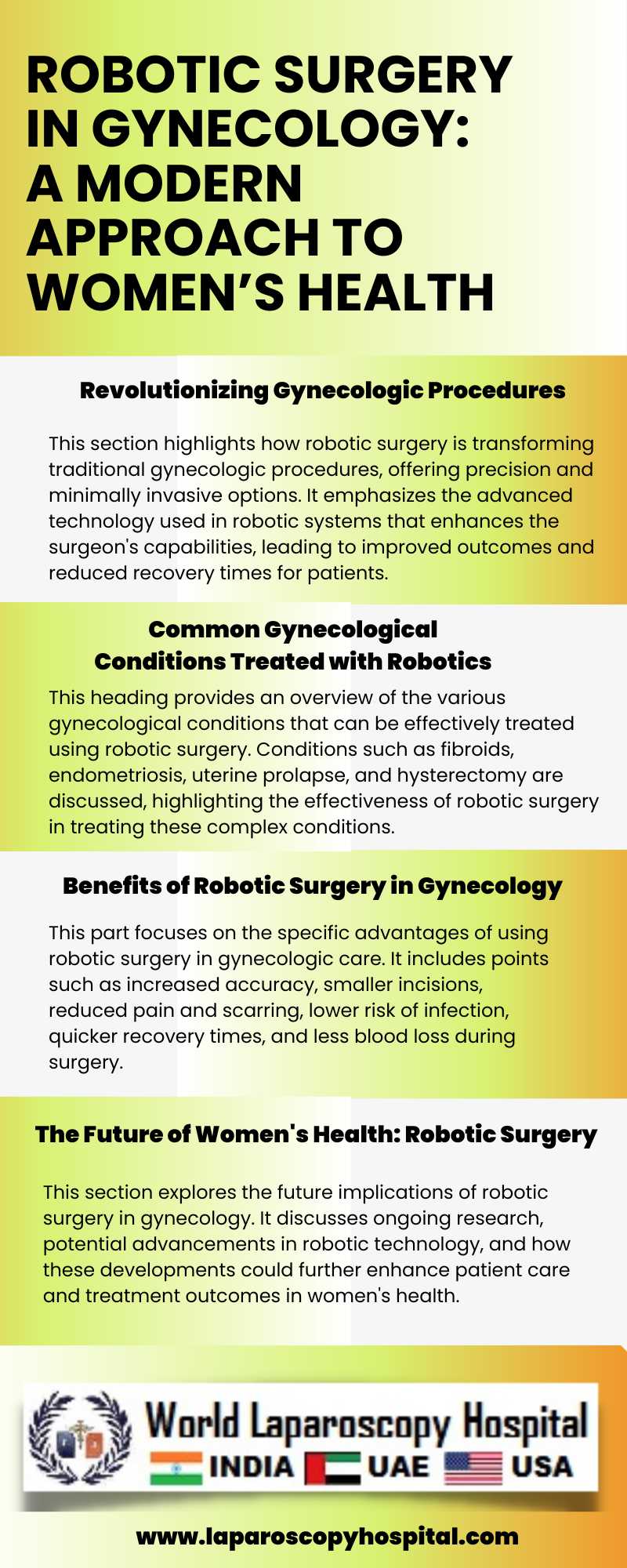Robotic Surgery in Gynecology: A Modern Approach to Women’s Health
Introduction
The advent of robotic surgery has revolutionized many fields of medicine, offering precision, flexibility, and control beyond the capabilities of traditional techniques. Gynecology is no exception to this technological advancement. This essay explores the impact and benefits of robotic surgery in gynecology, analyzing its role in improving women's health care.

Background
Robotic surgery, also known as robot-assisted surgery, allows doctors to perform complex procedures with more precision, flexibility, and control than is possible with conventional techniques. In gynecology, this technology is particularly advantageous for procedures like hysterectomies, myomectomies, and endometriosis resections.
Advantages
1. Precision and Accuracy: Robotic systems provide surgeons with a high-definition, 3D view of the surgical site and allow for more precise movements, reducing the risk of damage to surrounding tissues.
2. Minimally Invasive Approach: Robotic surgery is typically performed through tiny incisions, leading to less blood loss, reduced risk of infection, and quicker recovery times.
3. Improved Accessibility: Complex gynecological surgeries that might be challenging to perform laparoscopically can often be accomplished more easily with robotic assistance.
4. Enhanced Recovery and Reduced Pain: Patients often experience less pain and quicker recovery, leading to shorter hospital stays and faster return to normal activities.
Challenges and Limitations
Despite its benefits, robotic surgery in gynecology also faces challenges:
1. Cost: The high cost of robotic systems can be a barrier, making it less accessible in certain regions or for certain institutions.
2. Training and Learning Curve: Surgeons require extensive training to operate these complex systems effectively.
3. Technological Limitations: While advanced, robotic systems are not suitable for all types of gynecological procedures.
Case Studies and Clinical Evidence
Several studies have demonstrated the effectiveness of robotic surgery in gynecology. For instance, a study comparing robotic hysterectomy with traditional methods found a significant reduction in hospital stay and postoperative complications. Another research highlighted the precision of robotic systems in treating endometriosis, often leading to better outcomes and less postoperative pain.
Future Prospects
The future of robotic surgery in gynecology is promising. With advancements in technology, these systems are becoming more sophisticated, potentially overcoming current limitations. Additionally, as more surgeons become trained and the cost of technology decreases, robotic surgery may become more accessible, further improving women’s health care.
Conclusion
Robotic surgery represents a significant step forward in gynecological care, offering enhanced precision, reduced recovery times, and improved overall outcomes. As technology continues to advance and become more accessible, it is poised to play an increasingly vital role in the field of women's health. The integration of robotic surgery into gynecological practices signifies not just a technological advancement but a commitment to providing the best possible care for women's health needs.
The advent of robotic surgery has revolutionized many fields of medicine, offering precision, flexibility, and control beyond the capabilities of traditional techniques. Gynecology is no exception to this technological advancement. This essay explores the impact and benefits of robotic surgery in gynecology, analyzing its role in improving women's health care.

Background
Robotic surgery, also known as robot-assisted surgery, allows doctors to perform complex procedures with more precision, flexibility, and control than is possible with conventional techniques. In gynecology, this technology is particularly advantageous for procedures like hysterectomies, myomectomies, and endometriosis resections.
Advantages
1. Precision and Accuracy: Robotic systems provide surgeons with a high-definition, 3D view of the surgical site and allow for more precise movements, reducing the risk of damage to surrounding tissues.
2. Minimally Invasive Approach: Robotic surgery is typically performed through tiny incisions, leading to less blood loss, reduced risk of infection, and quicker recovery times.
3. Improved Accessibility: Complex gynecological surgeries that might be challenging to perform laparoscopically can often be accomplished more easily with robotic assistance.
4. Enhanced Recovery and Reduced Pain: Patients often experience less pain and quicker recovery, leading to shorter hospital stays and faster return to normal activities.
Challenges and Limitations
Despite its benefits, robotic surgery in gynecology also faces challenges:
1. Cost: The high cost of robotic systems can be a barrier, making it less accessible in certain regions or for certain institutions.
2. Training and Learning Curve: Surgeons require extensive training to operate these complex systems effectively.
3. Technological Limitations: While advanced, robotic systems are not suitable for all types of gynecological procedures.
Case Studies and Clinical Evidence
Several studies have demonstrated the effectiveness of robotic surgery in gynecology. For instance, a study comparing robotic hysterectomy with traditional methods found a significant reduction in hospital stay and postoperative complications. Another research highlighted the precision of robotic systems in treating endometriosis, often leading to better outcomes and less postoperative pain.
Future Prospects
The future of robotic surgery in gynecology is promising. With advancements in technology, these systems are becoming more sophisticated, potentially overcoming current limitations. Additionally, as more surgeons become trained and the cost of technology decreases, robotic surgery may become more accessible, further improving women’s health care.
Conclusion
Robotic surgery represents a significant step forward in gynecological care, offering enhanced precision, reduced recovery times, and improved overall outcomes. As technology continues to advance and become more accessible, it is poised to play an increasingly vital role in the field of women's health. The integration of robotic surgery into gynecological practices signifies not just a technological advancement but a commitment to providing the best possible care for women's health needs.
1 COMMENTS
Dr. Laxmi Tripathi
#1
Jan 14th, 2024 10:02 am
Robotic surgery is a significant leap in gynecological care, providing enhanced precision, shorter recovery times, and improved outcomes. As technology advances and becomes more accessible, it is poised to play a vital role in women's health, reflecting a commitment to delivering optimal care.
| Older Post | Home | Newer Post |





